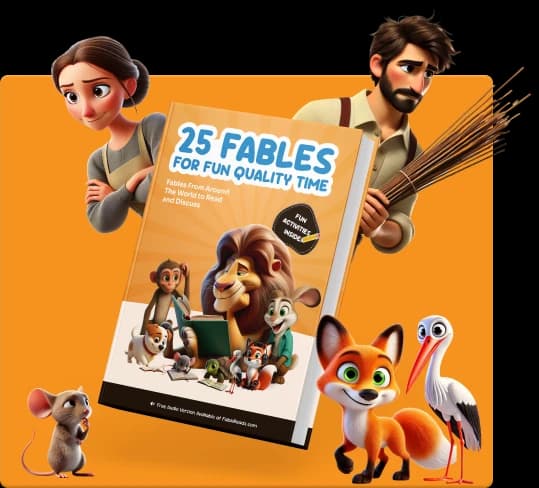Aesop | Greece
Der Fuchs und der Holzfäller
Ein Holzfäller rettet einen Fuchs, verriet aber sein Versteck; der undankbare Fuchs rannte weg und fühlte sich betrogen.

Es war einmal ein schlauer Fuchs, der vor ein paar Jägern und ihren Hunden davonlief. Der Fuchs musste fliehen, also rannte er in das Haus eines Holzfällers in der Nähe. Der Holzfäller war ein freundlicher Mann und hatte Mitleid mit dem verängstigten Fuchs. Er sagte dem Fuchs, er solle sich in seinem Haus verstecken.
Bald darauf kamen die Jäger und klopften an die Tür des Holzfällers. Sie fragten, ob er den Fuchs gesehen hätte. Der Holzfäller wollte sein Versprechen gegenüber dem Fuchs nicht brechen, aber er wollte auch nicht lügen. Also sagte er, er habe den Fuchs nicht gesehen, zeigte aber gleichzeitig heimlich auf den Ort, wo sich der Fuchs versteckte. Die Jäger verstanden den Hinweis nicht, bedankten sich beim Holzfäller und gingen weiter, um woanders zu suchen.
Als es wieder sicher war, kam der Fuchs heraus und wollte gehen. Der Holzfäller erwartete, dass der Fuchs sich bei ihm bedankte, aber der Fuchs machte sich einfach auf den Weg. Der Holzfäller war überrascht und fragte den Fuchs, warum er sich nicht für die Hilfe bedankte.
Der Fuchs sagte: „Wenn du mir wirklich helfen wolltest, hättest du den Jägern keine Hinweise gegeben, wo ich mich versteckt habe.“ Nach diesen Worten ging der Fuchs zurück in den Wald und der Holzfäller dachte darüber nach, was er getan hatte.
Kaufen Sie ein Buch und helfen Sie dabei, Fabeln in die Welt zu bringen
Genießen Sie 25 ausgewählte Fabeln fürs Leben, gedruckt. Jeder Kauf unterstützt kostenlose Geschichten für Kinder, Eltern und Lehrer weltweit auf fablereads.com

















